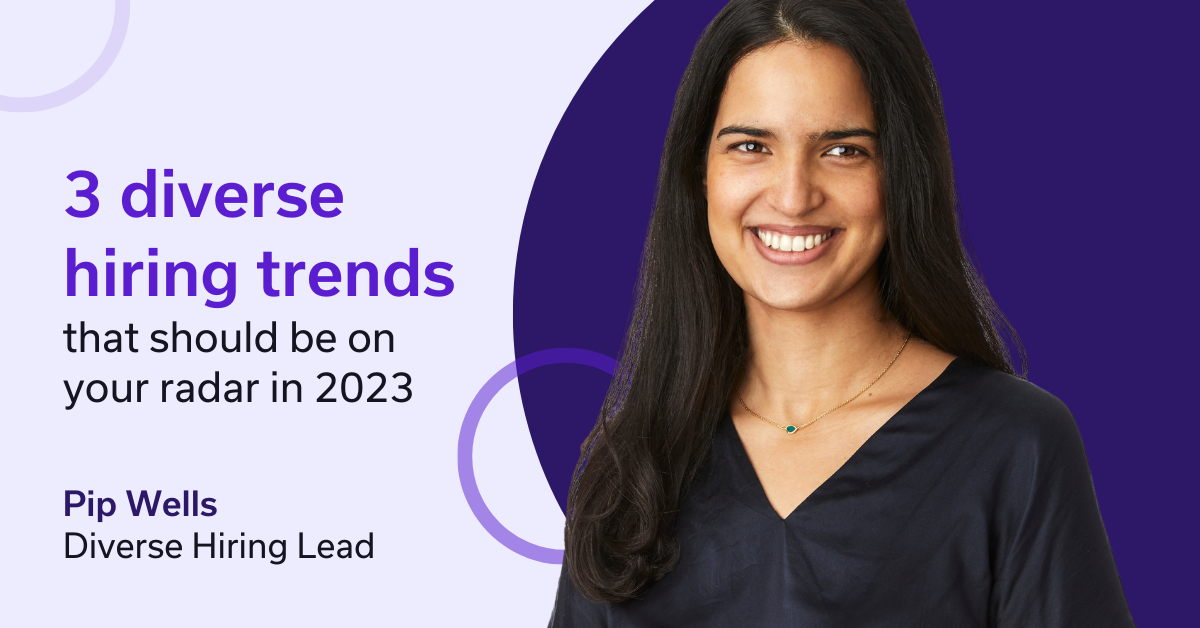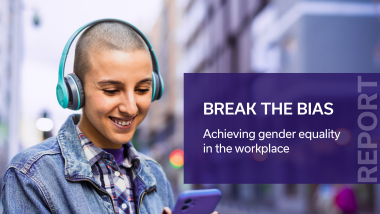3 diverse hiring trends that should be on your radar for 2023
Resource Solutions’ Diverse Hiring Lead Pip Wells is a diverse hiring expert and thought leader, recognised for her pioneering and award-winning work on our Recruitment Inclusivity Audit. In this conversation, Pip and Jo Goatcher, Senior Talent Acquisition Consultant at our return-to-work programme Rejoin, discuss 2023’s most essential diverse hiring trends.
Read on for fascinating insights into the four-day workweek, salary transparency, and increased government interventions regarding the ethnicity pay gap.
The four-day working week
Jo: There’s been a lot of press on the four-day working week following the UK trial in June. What is your view on this having a positive impact on gender equality?
Pip: As we know the four-day working week emerged from the pandemic to usher in a new era of work. The UK trial is measuring productivity as well as the well-being of workers, impact on the environment and gender equality, which is music to my ears because traditionally the five-day working week has been the domain for men. Working hours are almost entirely gendered. In the UK, for example, women are more than twice as likely to work part-time compared to their male counterparts – but this is on the rise for men, and in Europe, this figure is even higher. A four-day working week is a good starting point to address this in the hope that employees work smarter and produce equal output as they would a full working week. Personally, I’m a huge advocate of not just women having an appropriate amount of free time with family or children but changing this so that men do too, which for me, is one of the most significant interventions for meritocratic change.
Jo: What is your take on this being successful in leading the frontier for a new quality of life?
Pip: In January 2022, Atom Bank – the U.K.’s first app-based bank – announced they were committed to their company’s new four-day working week, which resulted in a 500% surge in job applications for the Durham-based business. However, whilst countries such as Iceland have already implemented a four-day working week with trials finding no corresponding drop in productivity — and a dramatic increase in employee well-being, Sweden trailed a four-day working week back in 2015 and found that there were mixed results. In the UK, the government is currently trailing the new working week – with no loss of remuneration – with more than 3,300 employees from over 70 companies taking part for 6 months. Two months in and we're hearing that the new routine is “life changing” and for most businesses the results have already exceeded expectations, so I am very hopeful.
Jo: I’ve seen you publicly highlight the importance of pay transparency. Why is this such a priority for you and your team?
Pip: Salary transparency
Purpose and meaning are important to many workers – but to be frank, it’s salaries that pay the bills. The UK, alas the world, is currently in the midst of a cost-of-living crisis, so you can imagine how important.
Whilst it may seem pretty innocuous to ask a candidate their current salary, employers are essentially inheriting a bias from a previous employer – rather than paying candidates what they perceive them to be worth, they’re paying candidates what they were previously worth – which can have harmful consequences. There’s a lot of research out there that suggests women – especially women from under-represented minorities and other underrepresented groups – fall into this category. The reason this is so significant is that this could have a huge impact on closing the various salary gaps – including everything from gender and ethnicity to LGBTQ+ and the disability pay gap –and help remove structural bias. One way of tackling this is to stop asking candidates their current salary and start advertising salaries on job descriptions.
Research by Glassdoor showed that 61% of candidates stated that “job compensation is the most important part of job description”, with 67% saying that salary was the top thing they looked out for in job descriptions. LinkedIn also used heatmaps to understand what candidates look for in job descriptions and to nobody’s surprise, candidates were instantly drawn to the salary.
However, unfortunately, we aren’t seeing this in many job descriptions at the moment. As part of International Women’s Day, the UK government piloted a new scheme in which organisations advertise salary as part of job descriptions. In the US, the state of New York passed a bill that now requires employers to post salary bandings on all job descriptions from December 2021. 14 other states have already implemented this law.
At the moment, it’s up to employers to share this information on job descriptions, but I suspect it’s just a matter of time before this becomes mandatory here in the UK.
Government interventions: The ethnicity pay gap
Jo: We’re starting to notice a bit of a theme here in terms of government interventions within the diverse hiring space. What’s your view on this?
Pip: You’re absolutely right. Mandatory gender pay gap reporting has been around for some time in the UK, but in Europe, we can see that legislation is also on the rise. The EU has announced that at least 40% of non-executive directors of publicly listed companies will need to be women. All publicly listed companies need to comply with this target by mid-2026. This was first presented to the European Commission ten years ago, so it’s interesting that it’s taken a decade to get this over the line.
Ethnicity pay gap reporting has also been debated several times in parliament over the course of the last few years. What we have also seen is that, back in March 2022, the UK government said that it would help companies tackle the ethnicity pay gap, but this wouldn’t be mandatory – as it is for gender. However, the business network Business in the Community (BITC) recently put pressure on all Conservative MPs in the prime ministerial race to ensure that ethnicity pay gap reporting is a mandatory requirement. Notably, some companies have already led the way in this space, such as HSBC, Zurich, Network Rail, and Deloitte. Each of these companies has all released their ethnicity pay gap reports to the public.
However, it's important to remember that ethnicity pay gap reporting is much more complex than gender pay gap reporting. This is because, when we break this down into smaller groups, they can potentially produce very different results within different sectors. My personal opinion is that we need to start “holding up the mirror” to understand where bias may exist in the first place. Will this be mandated in the UK? Only time will tell.
Jo: These are all fascinating topics, but what can organisations do to minimise bias in the hiring process?
Pip: Our diverse hiring team developed the Recruitment Inclusivity Audit that examines a client’s end-to-end recruitment process. We analyse the impact of your process on candidates using eight candidate lenses: gender, ethnicity, disability and neurodiversity, LGBTQ+, age, faith, socio-economic background, and veterans. We apply the findings of over 100 respected academic research papers, studies, and best-in-class examples to unearth the hidden biases that may be embedded in an organisation’s recruitment processes.
Earlier this year we worked with King’s College Hospital NHS Foundation Trust - one of London's largest and busiest teaching hospitals. They were keen to understand how the current recruitment and hiring process impacted talent from different communities.
Our Inclusivity Audit analysed 257 data touchpoints for bias, providing 49 bespoke, immediate and actionable recommendations for meaningful change.
Funmi Onamusi, Director of Equality, Diversity & Inclusion, King’s College Hospital NHS Foundation Trust quoted us as a “recognised standard in the world of diversity and inclusion for organisations to reach and then build upon” and was very pleased the process had given them the ability to grow.
We’re proud our audit process enables us to hold up a mirror to our client’s recruitment process and advise on removing barriers. It’s one of the things that I love most about my job – being able to see tangible changes being implemented within organisations, such as removing salary requirements and promoting salary transparency.
To find out more about our award-winning Recruitment Inclusivity Audit and how it can help you create a more inclusive hiring process, click here.













